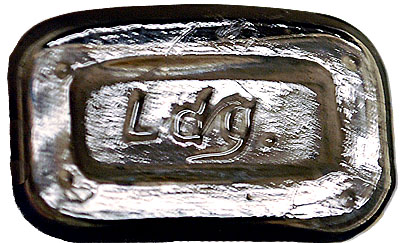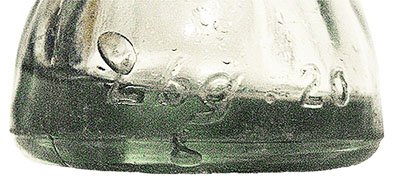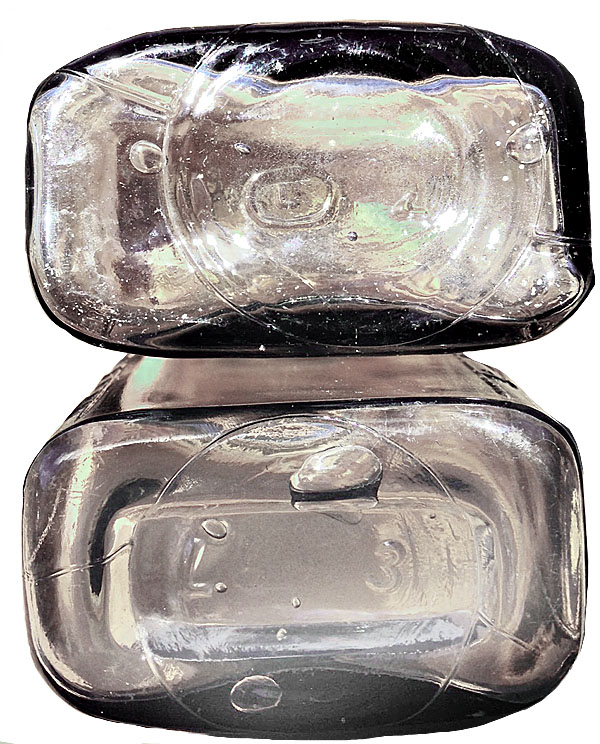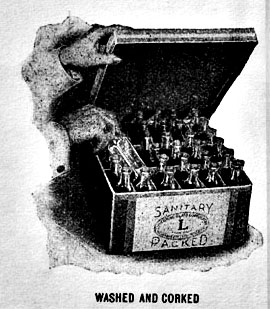Site Menu
Lynchburg Glass
Site Contents
CD Styles
Insulator Features
Mysteries
Anomalies
Production Data
Historical Archive
Gayner
Birmingham
|
Is It a Lynchburg? Like many glass houses of the 1920s, both incarnations of the Lynchburg Glass factory used maker's marks or logos to identify their wares. For collectors and historians, these marks help identify what a particular company made and in some cases when it was made. However, since other companies used similar marks, there has been some confusion as to what was actually made by the two Lynchburg companies (see The Story of Lynchburg Glass). Still, with a little information it is fairly easy to distinguish Lynchburg products. Lynchburg Glass Works The original Lynchburg Glass Works primarily produced oval medicinal or prescription bottles in various sizes, food containers, as well as Coca-Cola soda and flavored drink, Chero Cola, Pepsi-Cola, and perhaps other soda and mineral water bottles. They used a simple mark, Lbg, sometimes followed by a period, on the base of their bottles and containers (see examples below). No other glass company used this mark, especially in the cursive style. In at least one mold, the b of the logo appears backwards as a d. Lynchburg's Coca Cola bottles also occur with the mark on the heel (lower side) of the bottle with or without the date code of 19 or 20. We do not know if Lynchburg Glass Works produced some ware without any markings. This version of the company never produced insulators.
An example of Lynchburg's logo on a one ounce medicinal bottle with the b backwards.
There exists a 16 ounce medicinal bottle with an L in a oval logo on the bottom in the same smoky clear color as most Lynchburg Glass Works wares. There also exists a similar bottle in nearly identical color with the more typical "lbg" logo on the bottom (see comparison photo below).
It is uncertain who made the bottle with the L in an oval logo, although it is almost certainly one of the Lynchburg companies. The earlier Lynchburg Glass Works normally did not use this logo on their ware. However, there is some evidence that they did, in fact, use the L in an oval as a corporate logo. No direct evidence survives from the original company. However, the illustration at right provides an important clue. It is part of an early corporate letterhead from the later Lynchburg Glass Corporation, which shows bottles in a case marked with the logo. It is clear from corporate records that the early Lynchburg Glass Corporation, which was in effect a reorganization of the Lynchburg Glass Works, intended to make bottles. So it is reasonable to conclude that they used a cut from the previous company on their letterhead. A later letterhead does not show the bottles (see The History of Lynchburg Glass Corporation). It is possible that the bottle above was made by the later Lynchburg Glass Corporation. However, it is unlikely. While there is extensive discussion in the surviving company records about insulators and fruit jars made by the company, as well as discussion about the possibility of making battery jars, there is no mention that they ever made bottles. While there was discussion about obtaining a license to make Coca-Cola bottles, they never obtained such a license. -3- Also, the glass color of the bottle, while consistent with Lynchburg Glass Works products, is different from most Lynchburg Glass Corporation's ware. So, an informed conclusion is that Lynchburg Glass Works made both bottles. If so, this suggests that on some ware they used the L in an oval logo, which was also used by the later Lynchburg Glass Corporation on insulators. However, this conclusion remains tentative. Lynchburg Glass Corporation
The rather detailed records we have of the Lynchburg Glass Corporation (1923-1925) tells us that they only made insulators and canning jars. -3- It is possible that they also made some bottles, although solid evidence is lacking (see Root Glass Company below). Lynchburg's official corporate seal was an L within an oval. This trademark was used on company letterheads and appeared on most of its insulator products as a logo and maker's mark. The logo was used throughout production from late 1923 until May, 1925. There are a few pieces that do not carry the logo. For example, the CD 205 Transposition did not have enough room on the skirt for the logo. A few molds of other styles also do not have the logo. The logo was not used on Lynchburg's canning jars, although the name LYNCHBURG appears on all jars made by the company. It is possible that Lynchburg also made insulators without any company markings. There exist three styles of insulators that are the same molds used for both Gayner and Lynchburg insulators of the same style, often with identical reverse lettering, only without any company name on the front (called No Names: CD 162, No. 36; CD 164, No. 38; CD 154, No. 44). It is possible that these were made by Lynchburg before adding their company name and logo, but we have little information to confirm this. However, it is also possible that they were made by Gayner. The existence of the No Name No. 9 (CD 106) in earlier Gayner versions that were never produced by Lynchburg suggests that at least some of the No Names were Gayner products (see "No Name" Lynchburgs? and Gayner Insulators at Lynchburg?). Root Glass Company Several Coca-Cola distributed soda water bottles exist that carry both the Root Glass Company name as well as an L in an oval logo. There are at least four molds of these and they occur in both the typical smoky clear of Lynchburg Glass Works bottles as well as a light greenish aqua. The ROOT name along with the date code 22 (1922) appear on the heel of the bottles and are very faint, not unusual for Root bottle markings. The L logo is nearly identical to Lynchburg's L in an oval logo and appears on the base of the bottles along with the city name, Culpeper, VA (see photos below).
photos courtesy Justin Stoudt This raises questions since there is no documented relationship between the Root Glass Company of Terre Haute, IN and either Lynchburg Glass company. The date would likely place the bottle after the Lynchburg Glass Works had closed (May, 1922) yet before the Lynchburg Glass Corporation began production (November, 1923). While Lynchburg Glass Works made bottles, including bottles for Coca-Cola, they had lost that license in 1921 and never regained it. Even allowing for the soda water bottles to be made in 1923, there is no record of the later Lynchburg Glass Corporation ever making bottles. In fact, the only mention in their records notes that they could not obtain a license to make Coca-Cola product bottles. -3- Still, there is an intriguing entry in the Minutes of the Board of Directors' meeting of August 17, 1923 for Lynchburg Glass Corporation, as they were preparing to get the reorganized plant back into production. Mr. Eller, the company president, "described his Western trip, which he took in the interest of the Company, to the Hemingray Glass Co., and also to the Root Glass Co., Terre Haute, Ind." -4- This confirms at least contact between Lynchburg Glass Corporation and the Root company. Root was the origin of the 1915 patented Coke "hobbleskirt" bottle and continued to supply Coca-Cola with bottles throughout its history. -5- At this point we can do little more than speculate in the absence of solid documentation. There are at least three possibilities to explain the L logo on Root bottles. First, if we assume that the L logo on the bottles indeed signifies Lynchburg, it is possible that the original Lynchburg Glass Works made the bottles under contract to Root Glass Company, even though we have no record of it. The color of some of the bottles matches closely that of Lynchburg Glass Works' other bottles as well as their 1919-1920 Coca-Cola hobbleskirt bottles. If so, given the date codes they would had to have been some of the last product the company made in early 1922. The fact that they were found with a full case of "Lbg" marked Coke bottles lends credence to this suggestion. -6- The fact that the bottles also occur in a lightly tinted aqua, a color in which a very few Lynchburg made Coca Cola bottles have been found (dated 1920), supports this scenario. Although it appears likely, we are not certain that the first Lynchburg company used the L in an oval trademark. And none of this addresses the issue of why the Root Glass Company would share its license with a competitor. Second, it is possible that at the startup of the second company, Mr. Eller worked out some arrangement with Root to manufacture the soda water bottles in late 1923 under contract with Root Glass using Root's molds. We know from existing examples that Root was making soda water bottles for Coca-Cola in 1923 for use in Virginia. -6a- It is highly unlikely that Mr. Gayner would risk using obviously marked molds of such a high profile glass house without permission. This approach would address Lynchburg's lack of license to use the Coca-Cola name. Such an arrangement would also make sense if it were seen as temporary pending Lynchburg's expected acquisition of the Coca-Cola license. As late as September, 1923, Mr. Eller was still confident of getting that license. -7- However, the absence of any mention of this in all of the documents we have from the company raises questions about this scenario. And this still leaves unanswered the question of why Root would share its license with a competitor. Third, the L in an oval on Root bottles may have nothing to do with Lynchburg and be an in-house marking used by Root. It would be unusual for them to use such a mark that was the corporate logo of a competing glass house. This would be less of a issue if the bottles were made while the Lynchburg companies were inactive, between May, 1922, and November, 1923. This would fit the time frame of the date codes on the bottles. However, it is unclear why Root would use such a symbol in addition to their own name, especially since the L in an oval symbol was the logo of a competitor. The second scenario obove seems most likely. However, at this point, we simply do not have enough solid information to verify the origin of the Root/L soda water bottles. Laurens Glass Works Some have assumed that the mark LGW on glassware of the late teens and early 1920s is associated with Lynchburg Glass Works, especially since early examples occur in slightly off clear colors similar to Lynchburg's. However LGW is a well-known maker's mark of the Laurens Glass Works of Laurens, South Carolina (1910-1996). It was used at least into the late 1950s. Laurens Glass Works also made the patented Coca-Cola bottle in 1919 and early 1920s, and later bottles for Dr. Pepper, Pepsi, Tru-Ade soda, and other soft drinks, as well as Longlife canning jars and other glassware.
Lynchburg Bottling Corporation / D. O. Cunningham Glass Co. There are soda bottles marked LBC on the base. Around the front they are marked "LYNCHBURG BOTTLING CORP./LYNCHBURG, VA/MINIMUM CONTENTS/7 FLUID OZ./THIS BOTTLE NEVER SOLD." On the reverse they are marked "REGISTERED/ D O C 1349." These are from the Lynchburg Bottling Corporation, which is listed in Lynchburg directories around 1915. LBC bottled Golden Crown Ginger Ale. -1- The glass color ranges from light greenish to light blue tinted. DOC indicates that the bottle was made by the D. O. Cunningham Glass Co. of Pittsburgh, PA. -2-
Latchford Glass Works The glass products most easily confused with Lynchburg's are those of the W. J. Latchford Glass Company of Los Angeles, CA. The company used an L in an oval logo on their ware that was identical to Lynchburg Glass Corporation's logo (see examples below). Organized in 1925, about the time Lynchburg Glass Corporation stopped production, it survived in various forms until around 1989 when it became part of Anchor Glass. Latchford made a variety of glassware including milk bottles, pressure ware for beer and liquor, small and large packer ware and jars, and were noted for their one and five gallon water bottles, Sparkletts water bottles, and Mission canning jars. They also made the "Newmark Special Extra Mason Jar," as well as other custom products (see below for an example of ware made for Nesbitt Products). Many of Latchford's products featured textured glass. The L in an oval logo was used from 1925 until around 1938.
Loyalhanna Brewing Company The Loyalhanna Brewery was located in Latrobe, PA., and was in operation from 1906-1920 making mostly beer. Most of their bottles were marked on the base with the company's logo, "LBCo" in a monogram. Both amber and aqua tinted bottles were made by the Cunningham Glass Company in Pittsburgh, PA. Other bottles exist bearing a similar monogram logo, but it is uncertain whether they are from the same company (see below, right). In any case, Lynchburg never used such a monogram as a logo.
L. G. Co. Several glass companies are known to have used this maker's mark in various forms. However, it was never associated with either of the Lynchburg glass companies. 1) L.G.Co. with a single number: Lockport Glass Company, Lockport, New York (1900-1919). 2) L.G.Co. with numbers or letters: Lindell Glass Company, St. Louis, Missouri (1875-1890). 3) L.G.CO. in an arc: Lyndeborough (or Lyndeboro) Glass Company, South Lyndeborough, New Hampshire (1866-1888). Lyndeborough Glass Company made insulators for the American Insulator Company for a short time around 1885. 4) L G CO with the number 52, on milk bottles: origin is uncertain, either the Lamb Glass Company, Mt. Vernon, Ohio (c.1920-1960s) or Liberty Glass Company, Sapulpa, Oklahoma. L. B. CO. This marking has been found on a light purple whiskey bottle. While some have claimed that it was made by Lynchburg Glass, its maker is unknown. Neither Lynchburg glass company made whiskey bottles and none of the glass from Lynchburg was ever produced with a formula that would result in sun-colored purple glass. Conclusions The original Lynchburg Glass Works using the mark "Lbg" never made insulators, only bottles and packer ware. It is possible that they also used an L in an oval logo on a limited number of bottles. From the records we have, Lynchburg Glass Corporation, which we know used the L in an oval logo, never made bottles and only made canning jars for a short time in 1925, all of which were clearly marked Lynchburg. -8- It is possible that Lynchburg Glass Corporation made a limited number of soda water bottles under contract with Root Glass, but this is unconfirmed. The Latchford company, which also used a L in an oval logo, never made insulators. So a good rule of thumb is that if it's . . . 1) a bottle or jar marked "Lbg" or "Ldg" (in error), it was made by Lynchburg Glass Works. 2) a medicinal bottle with an L in an oval logo on the base with no other numbers or letters, it was likely made by Lynchburg Glass Works. 3) an insulator with the L in an oval logo, it was made by Lynchburg Glass Corporation. 4) a bottle or jar with an L in an oval logo with numbers, somtimes with other information, it was likely made by Latchford and not by either Lynchburg Glass Works or Lynchburg Glass Corporation. The one exception is the Root marked soda water bottles that also carry an L in an oval logo, which may have been made by one of the Lynchburg companies. 5) a bottle or jar with various markings containing L. B., L. G., or LGW, it was made by one of several other glass houses. Identifying Maker's Marks
Notes 1. The Bulletin, Department of Agriculture and Immigration of Virginia, Dairy and Food Division, Quarterly Report for the Period of March 1, 1916 to May 31, 1916, Richmond, 1916, p. 23; accessed August 23, 2014. There are references to the company as bottlers of Golden Crown Ginger Ale: Official Gazette of the United States Patent Office, Volume 210, January, 1915, Washington, 1915. pp. xvii, xxxi, lxxi, cxix, 715; accessed August 23, 2014. 2. Thanks to Bob Stahr for this information. For details about the various Cunningham glass houses, see Bill Lockhart, et. al, "The Dating Game: Cunningham Family Glass Holdings," in Bottles and Extras, Summer, 2005, pp. 2-8; accessed August 23, 2014. 3. "The President made a statement that he had not as yet been able to obtain a license from the Coca-Cola Co., Atlanta, Ga. for the manufacture of Coca-Cola Bottles.". "They . . . found after they were ready to start that the Coca-Cola Co. had taken away the franchise for making their bottles and given it to a Western house." Letter, January 10, 1927, Mr. Loyd to C. L Scott. 5. David Whitten, Root Glass Company, accessed September 2, 2014. 6. Personal correspondance from Justin Stoudt, July 29, 2014. 6a. The existing bottle is a green aqua and is lettered COCA~COLA BOTTLING CO./ SODA WATER on one side, LYNCHBURG, VA. / CONTENTS 6 1/2 OZ. on the other side and ROOT 23 on the heel. Information courtesy of Justin Stoudt. 7. "The President . . . felt encouraged and that he was making some progress in getting this license, from the fact that he had 9 or 10 letters from large Coca-Cola Bottlers in this State and North Carolina, and that he was making effort to get requests from all of them, asking the Coca-Cola Co. that we be granted this license." Minutes, September 4, 1923 8. "The next corporation [Lynchburg Glass Corporation] which was practically a reorganization of the first stockholders, shipped two hundred and sixty thousand dollars in insulators, including a small amount of jars made just before they closed down." Letter from W. H. Loyd to Jonathan Berkley, January 24, 1927. |
Copyright © November 25, 2019 , Dennis Bratcher
Last modified: November 25, 2019 11:23 AM


























